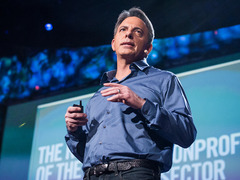
In 1994, Dan Pallotta created the AIDS Rides — a series of long-distance fundraising cycling journeys that netted $108 million for HIV/AIDS research and services within the space of eight years. Later, his Breast Cancer 3-Day walks netted $194 million in an even shorter period of time. Both had their best years ever in 2002. But then, after a spate of bad press criticizing the management of the organization, both were shuttered.
 Dan Pallotta: The way we think about charity is dead wrong
“350 employees lost their jobs because they were labeled overhead,” says Palotta in today’s talk, given at TED2013. “This is what happens when we confuse morality with frugality.”
Dan Pallotta: The way we think about charity is dead wrong
“350 employees lost their jobs because they were labeled overhead,” says Palotta in today’s talk, given at TED2013. “This is what happens when we confuse morality with frugality.”
This wasn’t just a problem for the newly unemployed or Pallotta’s wounded sense of pride. As he explains in this talk, the real issue is that everything we have been taught to think about charity is wrong. In particular, the single yardstick generally used to measure the worthiness of a charity – how much money goes directly toward the people it seeks to help and how much is used to cover overhead — is dangerously unhelpful. According to this thinking, the “best” charities are the ones with the lowest overhead. In fact, that focus may actually be preventing charities from making a real impact.
“The things we’ve been taught to think about giving and charity and the non-profit sector are actually undermining the causes we love … Our social problems are massive in scale, our organizations are tiny up against them — and we have a belief system that keeps them tiny,” says Pallotta, the author of the book Uncharitable. “We have two rulebooks—one for the non-profit sector and one for the rest of the economic world. It’s an apartheid.”
It’s time to change the way we think about giving to charity, says Pallotta. “Don’t ask about the size of their overhead,” he urges. “Ask about the size of their dreams.”
Curious to hear more on this new way of evaluating nonprofits, we asked Pallotta to share his thoughts on how to find a charity to support and what questions to ask along the way. Here’s what he had to say:
I want people to consider themselves a philanthropist no matter how much or how little they are giving. Even if you are giving $25, you are still a philanthropist. I advise people to figure out what cause they want to have an impact on, and take time doing research to find out the organization they feel is doing the best work on that problem. Then, make them your charitable partner for life. Continue to follow their progress, continue to learn about them, and continue to invest in them. You make a lot of inquiries before you buy a car or before you cast your vote for president – do the same thing before you cast your vote for a charity with your contribution.
1) How do I find the right charity for me?
Start with a broad search and narrow it from there. You can use websites like GreatNonprofits.org, Philanthropedia and GiveWell.org. They each have flaws. I say—use them, but don’t rely on them.
Then, do in-person interviews with your top two or three. Call the charity and ask for a tour or overview meeting. That’s why charities have development departments — to nurture and build relationships with donors. If you are going to make a long-term commitment to an organization, even if the money isn’t huge, you owe it to yourself to do this kind of research in the same way you would go to a dealership to test-drive a car.
I also recommend looking at a charity’s annual report. Does it inspire you? Does it seem to have a sense of mission, bravery, boldness — or is it cautious and formulaic? Check out Invisible Children, Share our Strength, and Charity Water to see examples of organizations that are inspiring, right down to their materials. Though in general, don’t just rely on a website.
2) Ask: what progress is the charity making toward its goals—and what metrics does it use to measure that?
Ask the charity to provide you with program data that tracks their activities — and ask how they measure their own progress. This question may be the most important of all — it really gets at what data they collect, how serious they are about that data collection, and how they shift behavior or strategy based on what the data is telling them.
But note, it doesn’t necessarily matter if the organization is effective. Some problems can be extremely difficult to solve, and you don’t want to punish the charities working on those problems — otherwise we’ll only get charities working on easy problems. Think about if you had asked Jonas Salk how effective he was one year before he found the cure for polio. He would not have been very effective at that point, but that doesn’t mean you would not have wanted to invest in him.
Bringing cold, hard business sense to running charities can help transform the philanthropic landscape for all and for the better, says Pallotta. “Overall, for each charity I give to, I ask myself if I believe in their business model and if I feel they have a bold future ahead of them,” he says.
Comments (48)
Pingback: Connect360’s Holiday Giving Guide: How to Choose a Charity - Connect 360 Multimedia
Pingback: CSR Success: How to Choose a Philanthropic Partner | Personal Branding Blog - Stand Out In Your Career
Pingback: Finding the Right Charity to Support | Philanthropy Times
Pingback: Tips for Selecting a Cause for Your Business to Support | BizCrunch
Pingback: The New Non Profits? | disrupting sex in school
Pingback: Quotes Dan Pallotta | vidhyanataraj2000
Pingback: RunForPurpose.org | Finding The Right Charity
Pingback: 20+ resources for better giving and living a more altruistic life | RXJ.TVRXJ.TV
Pingback: 20+ resources for better giving and living a more altruistic life | Krantenkoppen Tech
Pingback: 20+ resources for better giving and living a more altruistic life | H Tanalepy
Pingback: The way we think about charity is dead wrong. | Timid Writings
Pingback: Boomers – Time to Rethink Our View of Non-Profits and Lend Them our Brain Power | Boomer For Life
Pingback: Pourquoi le social business a de l’avenir… | Aventure Equitable 2013
Pingback: How to pick the charity that’s right for you | Looking For A Charity?
Pingback: Wizmo Blog » Blog Archive » How to pick the charity that’s right for you